TV REVIEWS : Nova Goes ‘In Search of Human Origins’
- Share via
Modern humans, people who looked pretty much like you and me and who probably behaved much the same way, have been around for about 100,000 years, most researchers agree. But our ancestors, primates who walked upright on the plains of Africa, who banded together for shelter and warmth and who may have used the simplest tools--like a twig to remove termites from a nest--have been around much longer, at least 3.2 million years.
That age is based on a 42-inch-tall fossilized skeleton found in a wasteland of bare rock and gravel in Ethiopia 20 years ago by a then-brash young anthropologist named Donald C. Johanson, who now heads the Institute for Human Origins in Berkeley. That skeleton, known as “Lucy” in honor of a Beatles song playing on the researchers’ tape deck when its identity was confirmed, is now arguably the most famous fossil in the world.
The story of that discovery and its impact on our search for the essential nature of humanity is the centerpiece of the first episode of the three-part “In Search of Human Origins,” an entertaining and thought-provoking “Nova” miniseries that debuts on PBS tonight. The series is hosted and narrated by Johanson, who has the makings of a charismatic and knowledgeable PBS host on the lines of Carl Sagan and David Attenborough.
(All three installments are running back to back tonight, from 8 to 11 p.m., on KCET-TV Channel 28. KVCR-TV Channel 24 is showing them at 7 p.m. tonight, Tuesday and Wednesday. KPBS-TV Channel 15 is showing them Tuesday at 7:30 p.m. and Wednesday at 7:30 and 8:50 p.m.)
Scarcely bigger than an 8-year-old, hairy and virtually indistinguishable from other primates, Lucy had one key characteristic that marked the transition between animals and men: Her knee-joint was capable of locking her leg straight, allowing her to walk upright for long periods of time and providing the mobility and versatility that started her line on the road toward modern humans.
Johanson frequently, and accurately, calls her the “missing link” between apes and humans, a term that is only now coming back into repute after earlier and more laughable claims disgraced it. “She is really the woman that shook up man’s family tree,” Johanson said recently.
In Part I, Johanson and his team re-create both their moment of discovery and the rather sedate celebration that led to her name. An English “movement artist,” heavily made up, portrays the last days of Lucy in the then-lush wilderness, and a highly detailed audio-animatronic Lucy head demonstrates how she might have used a twig to capture termites from their mounds.
Part II tells the story of how this frail creature and her brethren, many of whom were actually closer in size to modern humans, were able to survive on the Ethiopian battleground. Early man was not the ferocious hunter so often depicted in mythology, but rather a timid scavenger who made his living by stealing carcasses after more powerful carnivores were finished with them, settling for fruits and termites and the like when nothing better came to hand.
On Wednesday, the final chapter moves forward in time to look more closely at the development of culture, perhaps the defining characteristic of humanity. It focuses largely on the much-maligned Neanderthal, a brutish species once thought to be our forebears but now known to be a separate lineage that became extinct 30,000 years ago, perhaps because they could not compete with anatomically modern humans.
Yet they shared many human traits. “They ate the same foods, hunted the same way, buried their dead, built the same kinds of fireplaces,” Johanson said. In many ways, he argues, Neanderthals were human. Being a modern human, he concludes, may be less about what we look like and more about how we behave.
More to Read
The complete guide to home viewing
Get Screen Gab for everything about the TV shows and streaming movies everyone’s talking about.
You may occasionally receive promotional content from the Los Angeles Times.






